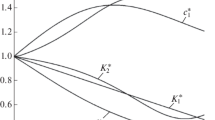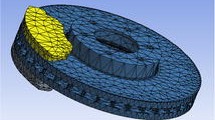Abstract
This paper presents a Fractional Derivative Approach for thermal analysis of disk brakes. In this research, the problem is idealized as one-dimensional. The formulation developed contains fractional semi integral and derivative expressions, which provide an easy approach to compute friction surface temperature and heat flux as functions of time. Given the heat flux, the formulation provides a means to compute the surface temperature, and given the surface temperature, it provides a means to compute surface heat flux. A least square method is presented to smooth out the temperature curve and eliminate/reduce the effect of statistical variations in temperature due to measurement errors. It is shown that the integer power series approach to consider simple polynomials for least square purposes can lead to significant error. In contrast, the polynomials considered here contain fractional power terms. The formulation is extended to account for convective heat loss from the side surfaces. Using a simulated experiment, it is also shown that the present formulation predicts accurate values for the surface heat flux. Results of this study compare well with analytical and experimental results.
Similar content being viewed by others
References
Du, S. ‘Thermoelastic Effects in Automotive Brakes’, Ph.D. Thesis, Mechanical Engineering, University of Michigan, Ann Arbor, 1997.
Du, S., Zagrodzki, P., Barber, J. R., and Hulbert, G. M. ‘Finite element analysis of frictionally excited thermoelastic instability’, Journal of Thermal Stresses20, 1997, 185–201.
Agrawal, O. P. ‘Fractional derivatives and its applicationin thermal analysis and properties measurements of disk brakes’, Quarterly Report, Center for Advanced Friction Studies, SIUC, May 2003.
Samko, S. G., Kilbas, A. A., and Marichev, O. I. Fractional Integrals and Derivatives – Theory and Applications, Gordon and Breach, Longhorne, Pennsylvania, 1993.
Oldham, K. B. and Spanier, J. The Fractional Calculus, Academic Press, New York, 1974.
Miller, K. S. and Ross, B. An Introduction to the Fractional Calculus and Fractional Differential Equations, Wiley, New York, 1993.
Gorenflo, R. and Mainardi, F. ‘Fractional calculus: Integral and differential equations of fractional order’, in Fractals and Fractional Calculus in Continuum Mechanics, A. Carpinteri and F. Mainardi (eds.), Springer-Verlag, Vienna,1997, pp. 223–276.
Mainardi, F. ‘Fractional calculus: Some basic problems in continuum and statistical mechanics’, in Fractals and Fractional Calculus in Continuum Mechanics, A. Carpinteri and F. Mainardi (eds.), Springer-Verlag, Vienna, 1997, pp. 291-348.
Rossikhin, Y. A. and Shitikova, M. V. ‘Applications of fractional calculus to dynamic problems of linear and nonlinear hereditary mechanics of solids’, Applied Mechanics Reviews50, 1997, 15–67.
Podlubny, I. Fractional Differential Equations, Academic Press, New York, 1999.
Butzer, P. L. and Westphal, U. ‘An introduction tofractional calculus’, in Applications of Fractional Calculus in Physics, R. Hilfer (ed.), World Scientific,River Edge, New Jersey, 2000, 1–85.
Kulish, V. V. and Lage, J. L. ‘Fractional diffusion solutions for transient local temperature and heat-flux’, ASME Journal of Heat Transfer122, 2000, 372–377.
Kulish, V. V., Lage, J. L., Komarov, P. L., and Raad, P. E. ‘A fractional-diffusion theory for calculating thermal propertiesof thin films from surface transient thermoreflectance measurements’, ASME Journal of Heat Transfer123, 2001, 1133-1138.
Battaglia, J. L., Cois, O., Puigsegur, L., Oustaloup, A. ‘Solving an inverse heat conduction problem using a non-integer identified model’, International Journal of Heat and Mass Transfer44, 2001, 2671–2680.
Carslaw, H. S. and Jaeger, J. C. Conduction of Heat In Solids, Oxford University Press, Oxford, 1959.
Reddy, J. N. and Gartling, D. K. The Finite Element Method in Heat Transfer and Fluid Dynamics, CRC Press, New York, 2001.
Beck, J. V., Blackwell, B., and St. Clair, Jr., C. R. Inverse Heat Conduction: Ill-Posed Problems, Wiley, New York, 1985.
Wriggers, P. and Miehe, C. ‘Contact constraints within coupled thermomechanical analysis – A finite element model’, Computer Methods in Applied Mechanics and Engineering113, 1994, 301–319.
Marx, D.T., Policandriotes, T., Zhang, S., Scott, J., Dinwiddie, R. B., and Wang, H. ‘Measurement of interfacial temperaturesduring testing of a subscale aircraft brake’, Journal of Physics D: Applied Physics34, 2001, 976–984.
Author information
Authors and Affiliations
Corresponding author
Rights and permissions
About this article
Cite this article
Agrawal, O. Application of Fractional Derivatives in Thermal Analysis of Disk Brakes. Nonlinear Dyn 38, 191–206 (2004). https://doi.org/10.1007/s11071-004-3755-7
Received:
Accepted:
Issue Date:
DOI: https://doi.org/10.1007/s11071-004-3755-7




